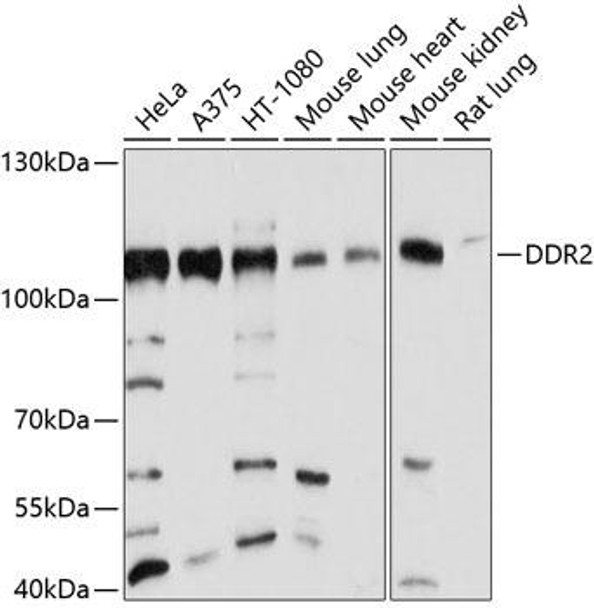Anti-DDR2 Antibody (CAB10060)
- SKU:
- CAB10060
- Product type:
- Antibody
- Reactivity:
- Human
- Mouse
- Rat
- Host Species:
- Rabbit
- Isotype:
- IgG
- Antibody Type:
- Polyclonal Antibody
- Research Area:
- Cell Biology
Description
| Antibody Name: | Anti-DDR2 Antibody |
| Antibody SKU: | CAB10060 |
| Antibody Size: | 20uL, 50uL, 100uL |
| Application: | WB |
| Reactivity: | Human, Mouse, Rat |
| Host Species: | Rabbit |
| Immunogen: | Recombinant fusion protein containing a sequence corresponding to amino acids 290-400 of human DDR2 (NP_001014796.1). |
| Application: | WB |
| Recommended Dilution: | WB 1:500 - 1:2000 |
| Reactivity: | Human, Mouse, Rat |
| Positive Samples: | HeLa, A375, HT-1080, Mouse lung, Mouse heart, Mouse kidney, Rat lung |
| Immunogen: | Recombinant fusion protein containing a sequence corresponding to amino acids 290-400 of human DDR2 (NP_001014796.1). |
| Purification Method: | Affinity purification |
| Storage Buffer: | Store at -20°C. Avoid freeze / thaw cycles. Buffer: PBS with 0.02% sodium azide, 50% glycerol, pH7.3. |
| Isotype: | IgG |
| Sequence: | NMFA KGVK IFKE VQCY FRSE ASEW EPNA ISFP LVLD DVNP SARF VTVP LHHR MASA IKCQ YHFA DTWM MFSE ITFQ SDAA MYNN SEAL PTSP MAPT TYDP MLKV DDSN TRI |
| Gene ID: | 4921 |
| Uniprot: | Q16832 |
| Cellular Location: | Cell membrane, Single-pass type I membrane protein |
| Calculated MW: | 96kDa |
| Observed MW: | 110kDa |
| Synonyms: | DDR2, MIG20a, NTRKR3, TKT, TYRO10 |
| Background: | Receptor tyrosine kinases (RTKs) play a key role in the communication of cells with their microenvironment. These molecules are involved in the regulation of cell growth, differentiation, and metabolism. In several cases the biochemical mechanism by which RTKs transduce signals across the membrane has been shown to be ligand induced receptor oligomerization and subsequent intracellular phosphorylation. This autophosphorylation leads to phosphorylation of cytosolic targets as well as association with other molecules, which are involved in pleiotropic effects of signal transduction. RTKs have a tripartite structure with extracellular, transmembrane, and cytoplasmic regions. This gene encodes a member of a novel subclass of RTKs and contains a distinct extracellular region encompassing a factor VIII-like domain. Alternative splicing in the 5' UTR results in multiple transcript variants encoding the same protein. |
| UniProt Protein Function: | DDR2: This tyrosine kinase receptor for fibrillar collagen mediates fibroblast migration and proliferation. Contributes to cutaneous wound healing. Belongs to the protein kinase superfamily. Tyr protein kinase family. Insulin receptor subfamily. |
| UniProt Protein Details: | Protein type:Membrane protein, integral; EC 2.7.10.1; Protein kinase, TK; Protein kinase, tyrosine (receptor); Kinase, protein; TK group; DDR family Chromosomal Location of Human Ortholog: 1q23.3 Cellular Component: focal adhesion; integral to plasma membrane; apical plasma membrane; plasma membrane Molecular Function:collagen binding; protein binding; transmembrane receptor protein tyrosine kinase activity; ATP binding Biological Process: extracellular matrix organization and biogenesis; ossification; peptidyl-tyrosine phosphorylation; collagen fibril organization; protein amino acid autophosphorylation; signal transduction; positive regulation of osteoblast differentiation; positive regulation of fibroblast proliferation; biomineral formation; positive regulation of protein kinase activity; positive regulation of transcription factor activity; cell adhesion; regulation of bone mineralization Disease: Spondylometaepiphyseal Dysplasia, Short Limb-hand Type |
| NCBI Summary: | This gene encodes a member of the discoidin domain receptor subclass of the receptor tyrosine kinase (RTKs) protein family. RTKs play a key role in the communication of cells with their microenvironment. The encoded protein is a collagen-induced receptor that activates signal transduction pathways involved in cell adhesion, proliferation, and extracellular matrix remodeling. This protein is expressed in numerous cell types and may alos be involved in wound repair and regulate tumor growth and invasiveness. Mutations in this gene are the cause of short limb-hand type spondylometaepiphyseal dysplasia. [provided by RefSeq, Aug 2017] |
| UniProt Code: | Q16832 |
| NCBI GenInfo Identifier: | 215273969 |
| NCBI Gene ID: | 4921 |
| NCBI Accession: | Q16832.2 |
| UniProt Related Accession: | Q16832 |
| Molecular Weight: | |
| NCBI Full Name: | Discoidin domain-containing receptor 2 |
| NCBI Synonym Full Names: | discoidin domain receptor tyrosine kinase 2 |
| NCBI Official Symbol: | DDR2 |
| NCBI Official Synonym Symbols: | TKT; WRCN; MIG20a; NTRKR3; TYRO10 |
| NCBI Protein Information: | discoidin domain-containing receptor 2 |
| UniProt Protein Name: | Discoidin domain-containing receptor 2 |
| UniProt Synonym Protein Names: | CD167 antigen-like family member B; Discoidin domain-containing receptor tyrosine kinase 2; Neurotrophic tyrosine kinase, receptor-related 3; Receptor protein-tyrosine kinase TKT; Tyrosine-protein kinase TYRO10; CD_antigen: CD167b |
| Protein Family: | Discoidin domain-containing receptor |
| UniProt Gene Name: | DDR2 |
| UniProt Entry Name: | DDR2_HUMAN |







